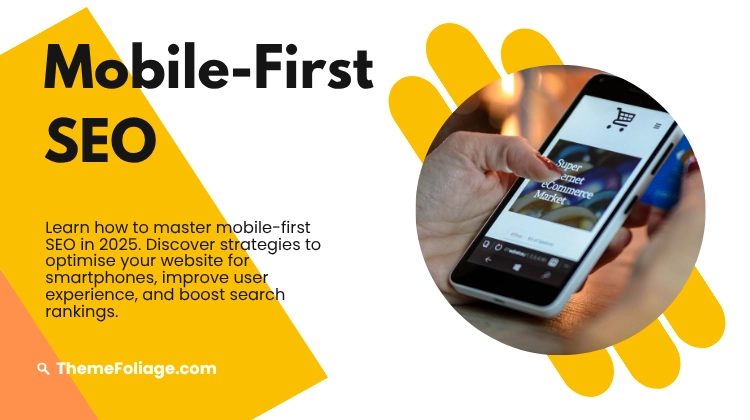Mobile devices now dominate internet usage globally. In 2025, more than 70% of all web traffic comes from smartphones, and Google’s mobile-first indexing ensures that your mobile site is the foundation of your search visibility.
Businesses that fail to optimise for mobile users risk losing rankings, engagement, and conversions. This guide explores the essential strategies for mastering mobile-first SEO in 2025.
What is mobile-first SEO?
Mobile-first SEO is the process of optimising your website to perform flawlessly on mobile devices. Google primarily uses the mobile version of your site for crawling and ranking, so ensuring that your mobile experience matches (or exceeds) your desktop version is crucial for long-term SEO success.
Why mobile-first matters in 2025
- Over 5.6 billion mobile users worldwide.
- Google exclusively uses mobile-first indexing.
- Mobile experience directly affects Core Web Vitals and engagement rates.
- Mobile-friendly websites see up to 30% higher conversion rates.
1. Prioritise responsive web design
A responsive design ensures your website automatically adapts to any screen size or orientation. Google recommends responsive design as the standard for mobile-first indexing.
- Use fluid grids and flexible images to maintain proportion across devices.
- Test layouts on multiple screen sizes using Chrome DevTools or BrowserStack.
- Avoid separate mobile URLs (like m.example.com), they create duplication issues.
2. Improve page loading speed
Mobile users expect instant results. Every second of delay can reduce conversions by up to 20%. Site speed is one of Google’s strongest mobile ranking signals.
- Compress images using next-gen formats such as WebP.
- Use lazy loading for offscreen images.
- Leverage browser caching and a CDN (Content Delivery Network).
- Minify CSS, JavaScript, and HTML.
3. Focus on Core Web Vitals
Google’s Core Web Vitals, Largest Contentful Paint (LCP), First Input Delay (FID), and Cumulative Layout Shift (CLS), directly impact both rankings and user satisfaction.
- LCP: Optimise above-the-fold content to load within 2.5 seconds.
- FID: Reduce JavaScript execution time and improve interactivity.
- CLS: Prevent layout shifts by setting size attributes on media elements.
4. Enhance mobile usability
Mobile usability is about how easy it is for visitors to navigate and interact with your site. Poor usability leads to high bounce rates and lost conversions.
- Use legible font sizes (at least 16px) and adequate spacing between clickable elements.
- Ensure buttons are large enough for touch input.
- Keep navigation simple and visible at the top of the page.
- Test usability with Google’s Mobile-Friendly Test.
5. Optimise for mobile search intent
Mobile search behaviour differs from desktop. Users typically search for quick answers, local services, or direct actions such as “buy now” or “call now.”
- Include click-to-call buttons and directions for local searches.
- Optimise for conversational, voice-friendly keywords.
- Provide concise answers and fast-loading landing pages.
6. Use structured data for better visibility
Structured data helps search engines understand your content and display rich results, which are especially useful on small mobile screens.
- Implement schema for FAQs, reviews, and product listings.
- Use JSON-LD format recommended by Google.
- Test your structured data with Google’s Rich Results Test tool.
7. Avoid intrusive interstitials
Google penalises sites that use intrusive pop-ups or overlays that obstruct mobile content. User experience always comes first.
- Avoid full-screen pop-ups on entry pages.
- Use small banners or timed exit-intent popups if necessary.
- Ensure important content remains easily accessible.
8. Optimise images and videos for mobile
Visual content must load quickly and fit seamlessly into small screens without breaking layout or functionality.
- Use responsive image attributes (
srcset) to deliver appropriate sizes. - Compress videos or host them on YouTube/Vimeo with lazy loading enabled.
- Add descriptive alt text for accessibility and SEO.
9. Implement AMP (Accelerated Mobile Pages) selectively
While AMP is no longer mandatory, it still provides benefits for news sites and blogs with high mobile traffic.
- Use AMP for content-heavy pages like articles or tutorials.
- Ensure AMP pages mirror your canonical pages in content and metadata.
10. Mobile-first content structure
Mobile users prefer concise, scannable content. Structure your pages to deliver value instantly.
- Use clear headings and subheadings.
- Place the most important information above the fold.
- Break content into short sections with bullet points and visuals.
11. Voice search optimisation
Voice assistants like Google Assistant and Siri have changed how users search. Mobile-first SEO must consider voice-based queries.
- Optimise for conversational, question-style keywords.
- Include structured data to help assistants retrieve relevant answers.
- Answer questions concisely within 50–60 words.
12. Monitor mobile analytics
Regular analysis helps you identify usability issues and performance gaps quickly.
- Track mobile bounce rate and session duration in Google Analytics.
- Compare mobile vs. desktop conversions.
- Use heatmaps (e.g., Hotjar) to study scroll behaviour on mobile devices.
13. Technical SEO considerations
Even small technical errors can affect mobile indexing and visibility.
- Ensure the mobile site includes the same metadata as the desktop version.
- Keep structured data, canonical tags, and hreflang tags consistent.
- Avoid blocking resources (CSS, JS, or images) in robots.txt.
14. Progressive Web Apps (PWAs)
PWAs combine the best of web and mobile app experiences. They load instantly, work offline, and enhance engagement — perfect for mobile-first SEO.
- Use PWAs to deliver app-like performance and push notifications.
- Ensure they’re crawlable and indexable by Googlebot.
Conclusion
Mobile-first SEO in 2025 is not optional, it’s foundational. With most users accessing content through smartphones, your site’s design, structure, and speed must prioritise mobile usability.
By implementing these techniques, you’ll improve rankings, boost engagement, and ensure your website remains future-proof in a mobile-driven world.
You also should learn Content Optimisation Techniques That Actually Work!



